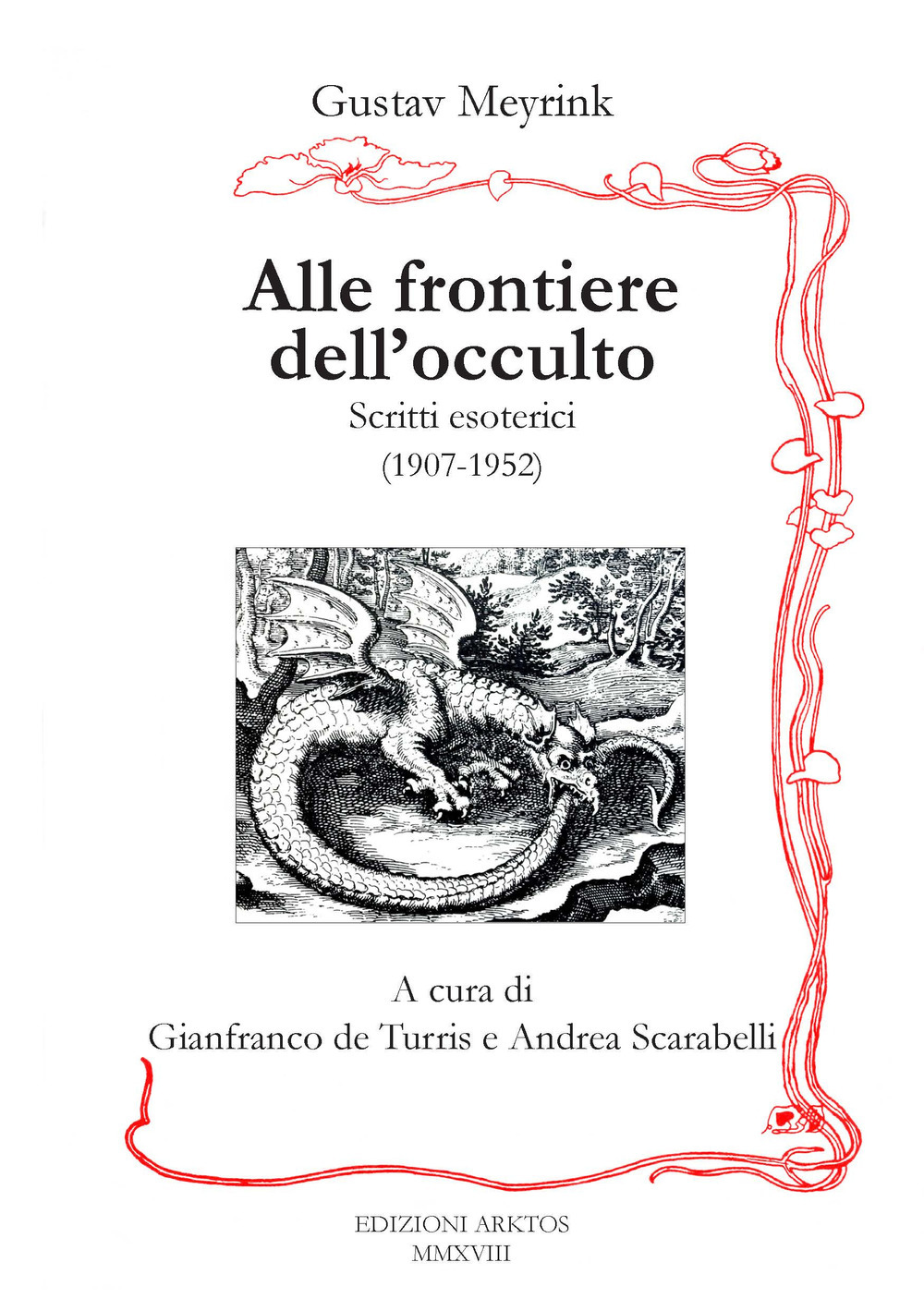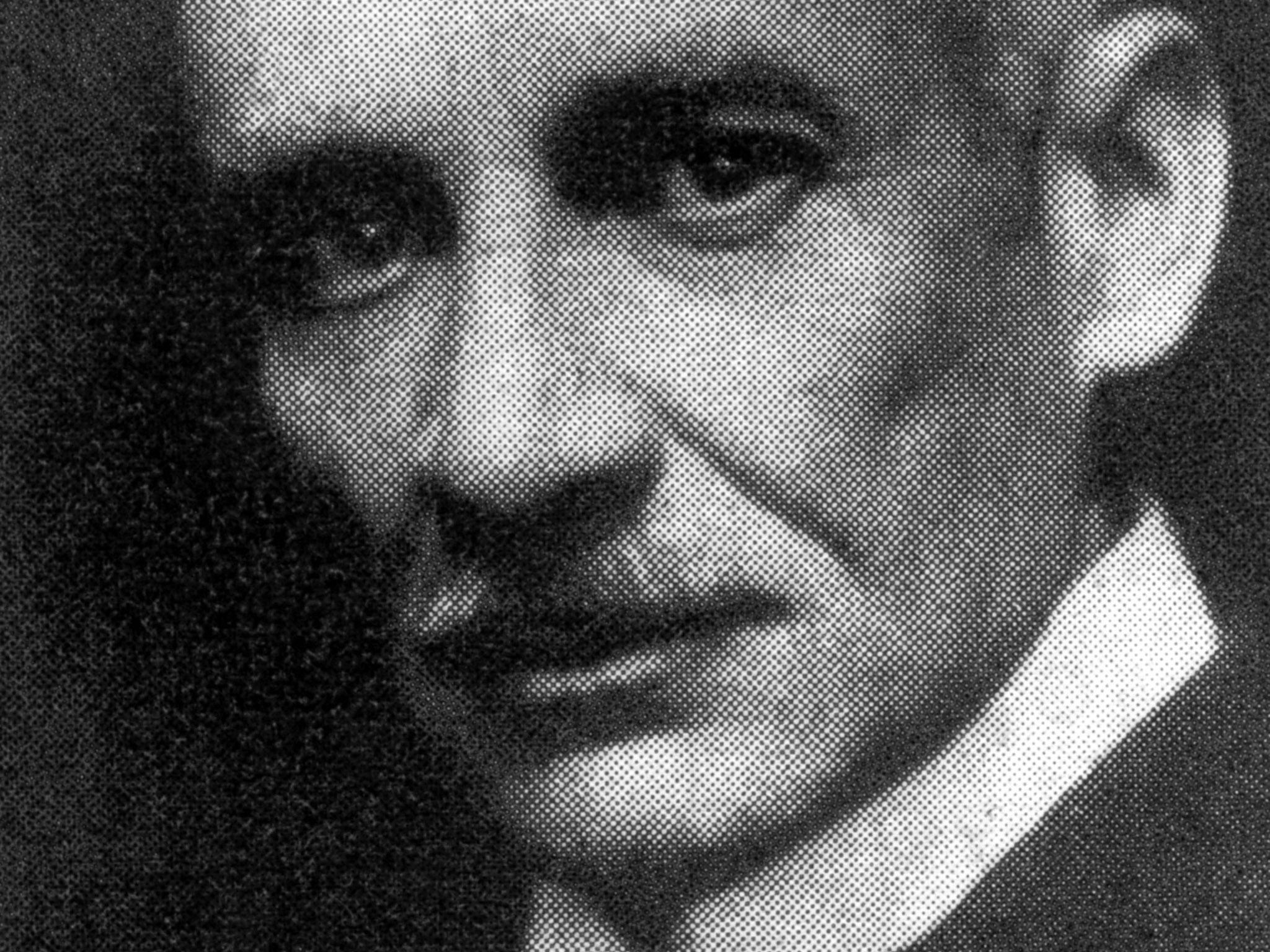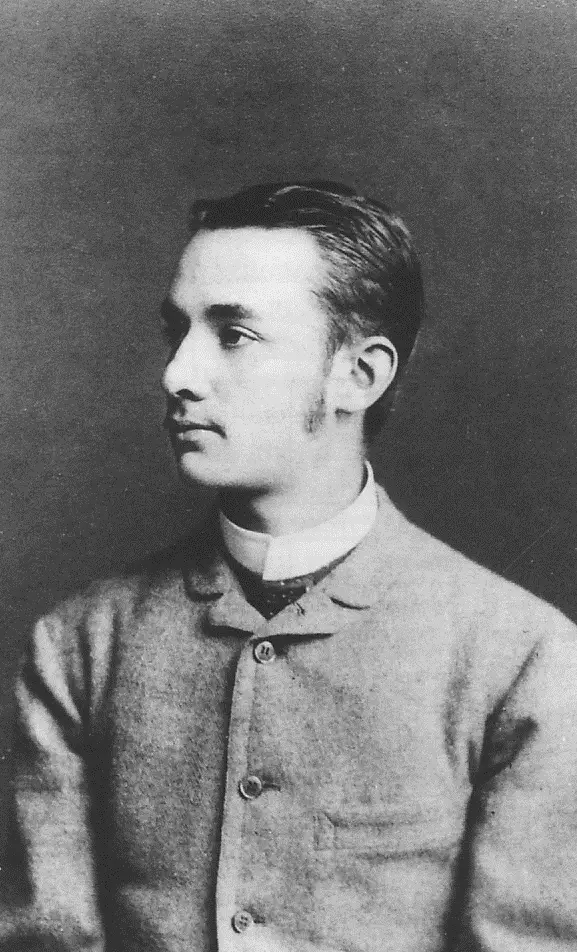The collection of Meyrinkian essays just published by Edizioni Arktos allows us to outline a portrait of the Austrian novelist, in which the biographical and the literary aspects are configured as two sides of the same coin.
di Marco Maculotti
image: frame from the film The Golem (1915), based on Meyrink's novel of the same name
"Tomorrow twenty-four years will have elapsed for me since that day of the Ascension when, sitting at the desk of my boy's room in Prague, and putting the farewell letter I had written to my mother in the drawer, I grabbed the revolver that I had in front of; I had in fact decided to undertake the journey beyond the Styx; I wanted to throw away an existence that seemed destined to remain dull, worthless and joyless in the future. " [1].
The young man with the revolver in his hand, ready to leave this "bitter valley of tears" forever, is an anonymous and wealthy Austrian banker with a hobby of women, chess and rowing. Sickened by his flat and insignificant existence, he prepares to make the final gesture. What stops him suddenly? A printout suddenly slipped under his bedroom door. The young man puts down his gun, gets up from his chair, picked up the paper and peeks at the title: "On life after death ".
Reading the mimeographed several times, the young man spends the night in a state of adrenalin-fueled wakefulness (la long night of the soul), "While thoughts, hitherto unrelated, began to pass [him] in his mind ... he took [and] the revolver as one does with an object that had temporarily become unusable and closed it [e] in a drawer". “I still keep it today. — concludes the author of this confession — He died of rust and the drum no longer turns; he will never turn again " [2].
To write this confession is, almost a quarter of a century after the incident, Gustav Meyrink, Austrian novelist considered one of the spearheads of that niche trend at the turn of the nineteenth and twentieth centuries definable as "esoteric literature". Until that moment completely unaware of any occult doctrine, he judges what happened to him that day of the Ascension as a message, sent to him by the mysterious "Guide with a hidden face", a supernatural and archetypal figure who will often return, more or less disguised. , in his writings. She is, as he writes Piero Cammerinesi [3]:
«The encounter with the metaphysical, with the signifying element of existence, with" chance ", which in an ordered cosmos cannot be without meaning. It is the "Guide with a hidden face" who from that moment takes over his life, transfusing it with new value, filling it with meaning. "
From that event, in fact, Meyrink's interests changed radically: abandoned the playful pastimes, begins his forty-year "search", plunging headlong into the world of occultism, spiritism, esoteric sciences, kabbalistic doctrines and oriental practices such as Yoga and the Tao. For decades he devoted himself to telepathic experiments, séances, alchemical transmutations, yogic and "magical" practices of any kind; personally experiences the intake of hallucinogens and poisons; he is interested in the phenomena of foresight, also developing considerable practical skills; he is initiated into a very large number of secret societies and para-Masonic lodges in continental Europe. The wealth of experience and knowledge thus acquired will constitute for Meyrink the true substratum and at the same time the core of his literary work, in which essential novels such as The Golem (1915) and The green face (1917) [4].
His works, quoting Cammerinesi again, «are alchemical novels, as Carl Gustav Jung had to affirm. Its encrypted contents tell us about the manifestation of the world of Archetypes, of Thesaurus Intelligibilium. They speak to us of the Other Part, of that Spiritual World that Meyrink will never show he doubts, considering it no less real than the world of the senses " [5]. Suggestions that will attract the attention of, among others Julius Evola, who dealt with Meyrink since 1927 by publishing some parts of his works on Ur and later translating three of his novels for the Italian public (The White Dominican, Walpurgis Night e The Angel of the West Window) and of Jorge Luis Borges, whose exceptional collection of short stories The Aleph (1949) betrays the influence of the labyrinthine atmospheres of The Golem, which he translated personally and presented to the Argentine public in 1938 ... without forgetting the admiration nurtured towards him by excellent colleagues such as Franz Kafka e Herman Hesse [6].

Nevertheless, Meyrink did not limit himself to translating into his literary creations the occult knowledge acquired and the experiences he had personally lived: he also collected them in various essays which, thanks to the commendable work of the types of Arktos editions, we now have the ability to read easily. This new edition entitled At the frontiers of the occult. Esoteric writings (1907-1952) takes the form of the fusion of two now unobtainable anthologies of the author's writings: The book of the afterlife, published by Rocco (Naples) in 1959 in the translation by Julius Evola e The magic plot, a collection of texts selected and translated by Piero Cammerinesi for Basaia (Rome) in 1983. In addition, the reader can also enjoy other very rare documents: four letters from Meyrink to Alfred Müller-Edler and the article My pains and my joys in the afterlife; in addition to an appendix of the Cammerinesi on the writer's biography and on the spiritual and metaphysical dimension permeating his works and the prefaces of Gianfranco de Turris e Andrea Beetles, editors of the edition. The edition is also embellished by the «pictorial incursions into the Elsewhere» by Danilo Capua.
The sixteen essays by Meyrink contained in this collection (seventeen if you also count the article in the appendix) they range from oriental doctrines (Fakirs, The Way of the Fakir, The Book of the Living God, Awakening of Occult Faculties by the Discipline of Will and Certain Drugs, The Magic Diagram, Tantric Yoga) to the western ones (Occultism, the invisible world, alchemy or impenetrability), including the critique of Theosophy and mediumistic spiritism that Meyrink considers phenomena on the whole more dangerous and deceptive than anything else. In some writings the author tells liminal experiences that occurred to him in the first person, like the psychedelic journey of Hashish and clairvoyance, the episodes of foresight in Telephone connection with the land of dreams, the astral journey told in Magic in deep sleep and attempts to influence gambling by virtue of some "superstitious" tricks in Magic and chance.
As he noted Sebastiano Fusco in his essay The fantastic, the horror and the esoteric in Meyrink (contained in the Italian collection entitled Chilling tales [7]) all the writings of the Austrian novelist (and those contained in this anthology are no exception) "draw a kind of symbolic image of the long journey the "way of awakening": the itinerary that the adept travels to overcome, in life, the human condition, and rekindle the divine spark present in each of us» [8]. Themes dear to the Eastern tradition, especially Hindu and Buddhist, including all the Far Eastern offshoots, but also to the occult doctrines of Gurdjieff and Ouspensky [9].
In Meyrink's vision, in fact — continues the Fusco —, who are "normal life is "sleep"; what we call "acting" and "learning" is nothing other than the almost automatic fruit of mechanical actions, which unfold on a strictly material level; who limits himself to conduct himself on this plane, wears out and consumes as a mechanism does, which eventually breaks, and remains inert matter. Instead, man "awakened" thanks to esoteric wisdom, breaks the shell of animality and he makes his consciousness ascend to the higher planes of being; "awake during life, it will remain awake even after physical death: his, and hers alone, will be eternity "" [10].
An approach well summarized also by Scarabelli in the preface to this new Arktos edition [11]:
« Those who do not experience Awakening cannot say that they are either alive or dead. He is below life and death, just as the Awakened is above them. Overwhelmed by material events, he is a shadow among other shadows. "

So what purpose does Meyrink assign to esoteric research? To put it differently, and this time in his own words, “nothing but gradually transform the human animal "covered with animal skins" and expelled from Paradise into the original and luminous man which, according to legends, tales and sacred books, has overcome death " [12]. Hence the conviction that "earthly existence is nothing more than a mysterious process, still little known to us, which makes a brilliant sparkling of lights out of a rough and opaque precious stone" [13]. In other words, it is a question of reactivating in man, quoting Paracelsus, the body that is not of Adam [14], the divine spark concealed in the physical body and completely obliterated by the positivist and materialistic science of the modern era; or to awaken, to say it in the Oriental, the siddhi, "Psychic energies ... [which] are either innate, or are awakened by the intake of certain herbs or by immersion in the deep self, or, again, by asceticism" [15].
Or again, through the Deep sleep, which Meyrink (similarly to distinguished colleagues such as Lovecraft [16], Machen and Borges [17]) consider a real "portal to the Elsewhere", to the point of believing that "there may be sources of magical strength and knowledge so far from our waking consciousness as to force us to immerse ourselves deeply in the recesses of sleep, if we want to approach them" [18] and to enunciate cryptically [19]:
« The pivot is in deep sleep: there is the foothold of the universe, on which the Archimedes lever can be placed to bring the stars out of their orbits. "
But, to return to the Meyrinkian "doctrine of awakening", how to evaluate the presence, in the writings of the author being analyzed here, of such a heterogeneous panorama of Christian mystics (Therese Neumann) and Hindus (Govinda Swami e srî Ramakrishna Paramahansa), fakirs and alchemists (Paracelsus), up to the "marshy" areas of theosophical occultism and spiritualistic currents? There are many ways, one could say, and each individual (and society) takes on the one most congenial to them, according to the spiritual level reached and the influences of historical, cultural and social origin. On the other hand, Meyrink seems to make the traditional thesis he considers his own il daimon as the highest forming and shaping force of the self of each human being. Position already noted by the aforementioned Fusco, according to whom in the stories of the Austrian writer [20]:
«… The thesis develops according to which each human being does not represent an autonomous" I ", but is the manifestation, in the span of an earthly existence, of a pre-existing and eternal god or demon. The path of redemption, or rather of reunification with the higher "I", it is described in different tones, sometimes terrifying, sometimes serene: which is in conformity with the esoteric teaching, which foresees different paths, some placid, mystical, lunar, others flaming, atrocious, burning like the sun. "
Not all of these "ways", however, lead to "salvation": Meyrink, after decades of study and experimentation, distanced himself above all from the theosophical, spiritualistic, mediumistic paths, having understood that "mediumism does not elevate the conscience, but brings it towards the subhuman, putting man in contact with destructive forces: it is the opposite of spiritual exercises and alchemy which, on the contrary, can lead, if properly exercised, to superconsciousness " [21]. It is exactly, as de Turris observes elsewhere [22]:
"... the danger pointed out over and over again by traditionalist thinkers like Guénon and Evola: the naive unconscious who initiate similar operations do not know exactly which entity they will evoke, what they will bring out from below and certainly not from above making it filter through those" cracks in the wall "that defends us from similar dangers ..."

There are many things to say about this new Arktos release and about Gustav Meyrink's biographical-literary epic; here, in conclusion of this short review, we would like to underline once again as well as from reading these essays it is clear how in Meyrink the biographical-practical and the literary-theoretical aspects are presented as two sides of the same coin, both relying on an unfailing belief in the "existence of great magical secrets thanks to which the predestined man could escape the web of sensible appearances and finally contemplate the true, the only Reality", to put it in Serge Hutin [23]. Not surprisingly, it was he himself who affirmed [24]:
« I care more about my theories, which are practice and life, than my artistic creations, which are their symbol and dress. »
It follows that, in the artistic exercise of the Austrian novelist, the "fantastic" is, in the final analysis, only "the aesthetic garment of a hidden reality and difficult to know by the layman" [25], to quote the article by Maximus Scaliger su Literary Italy of 15 September 1934, in which the author also adds [26]:
"It is an experience not of an intellectual order, but one that could be said to be pre-intellectual, in which the aesthetic activity is simply subservient to the resonance of a deeper and more unknown world, and the most turbidly fantastic constructions are not than the manifestation of a lucid inner reality. "[...]
"And from vision to vision, from thought to thought, it leads to the clear perception of a unique wisdom over time, in which the reality of a supernatural experience shines through and the sense of cathartic preparation is understood as an introduction to the" Way "that ... it discloses to man the pure, luminous, power. "
Gustav Meyrink leaves this world on the evening of December 4, 1932. After saying goodbye to his family, he retires to his room and sits, shirtless in spite of the cold, on the armchair opposite the window. He stays like this all night, contemplating the starry sky, the dawn and the rising sun; then, still with his eyes in adoration, he expires peacefully. His wife Mena defines the experience of her husband's passing as "a solemn mass of religion and nobility" [27] and tells, in a letter collected in this edition Arktos [28]:
“His eyes grew brighter and brighter and at half past six in the morning of Sunday December 4th he took his last breath. There was a dismayed joy in us to see how his great Spirit was harmoniously detached. His body remained, like a larva: the butterfly soared upwards. »
PS Those interested in Meyrink's work can follow the Austrian novelist's rediscovery work in Italy by keeping an eye on the Facebook page of the Gustav Meyrink Study Center of the City of Evan, a project conceived by his friend Ivan Capra.
Note:
[1] G. Meyrink, At the frontiers of the occult. Esoteric writings (1907-1952), Arktos, Carmagnola 2018, p. 261.
[2] Ivi, p. 262.
[3] P. Cammerinesi, Gustav Meyrink and the path of awakening, appendix to G. Meyrink, At the borders, op. cit., p. 313.
[4] For a significant excerpt from The green face, you see Gustav Meyrink: "The green face", on AXIS mundi.
[5] P. Cammerinesi, op. cit., p. 295.
[6] For a tribute by Hesse to Meyrink cf. this article on the blog of A. Scarabelli.
[7] G. Meyrink, Chilling tales, edited by G. Pilo and S. Fusco, Newton Compton, 1993.
[8] St. Fusco, The fantastic, the horror and the esoteric in Meyrink, in G. Meyrink, Stories chilling, op. cit.
[9] See J. de Salzmann, The reality of being. The fourth way of Gurdjieff, Astrolabio-Ubaldini, Rome, 2011, JG Bennett, Gurdjieff. A new world, Astrolabio-Ubaldini, Rome, 1981 and PD Ouspensky, Tertium Organum, Astrolabio-Ubaldini, Rome, 1983.
[10] S. Fusco, op. cit.
[11] A. Scarabelli, preface to G. Meyrink, At the borders, op. cit., p. 32.
[12] G. Meyrink, At the borders, op. cit., p. 79.
[13] Ibid, pp. 79-80.
[14] Ibid, p. 101.
[15] Ivi, p. 197.
[16] In this regard, cf. M. Maculotti, “Oniricon”: HP Lovecraft, the Dream and the Elsewhere, on AXIS mundi.
[17] Borges' writing on Meyrink accessible to the Italian public is the afterword a Cardinal Napellus and other stories (SE, Milan, 2011), which also highlights the importance of the dream element in the prose of the Austrian novelist ("... dreams dreamed of by other dreams, nightmares lost in the center of other nightmares ...», P. 70).
[18] G. Meyrink, At the borders, op. cit., pp. 224-225.
[19] Ivi, p. 225.
[20] S. Fusco, op. cit.
[21] P. Cammerinesi, op. cit., p. 300. Meyrink believed in the existence "although certainly extremely rare, of phenomena that overturn, so to speak, everything that science thinks it knows about the laws of physics" and added "from that moment [that is, after some particularly shocking experiments in the mediumistic field, ed] no longer attempted experiments in the field of spiritism and all that is directly connected to it: what I have seen is enough for me and advances(Our italics).
[22] G. de Turris, Awakening according to Gustav Meyrink, preface to G. Meyrink, The white Dominican, Bietti, Milan, 2012, p. 13.
[23] S. Hutin, The great liberating enlightenment, appendix to G. Meyrink, Dominican, op. cit., p. 242.
[24] Cit. in J. Evola, Message, appendix to G. Meyrink, Dominican, op. cit., p. 231.
[25] M. Scaliger, Mysticism and narrative: what's in Meyrink, appendix to G. Meyrink, Dominican, op. cit., pp. 221-222.
[26] Ibid, pp. 220-224.
[27] P. Cammerinesi, op. cit., p. 325.
[28] Ivi, p. 326.

Congratulations always very fascinating themes… ps does the green quotation mark have a vegetable alchemical reference or a casual aesthetic choice?